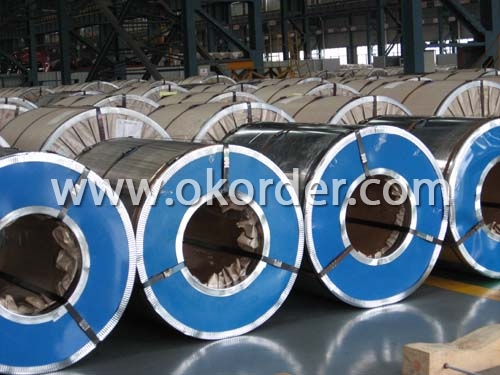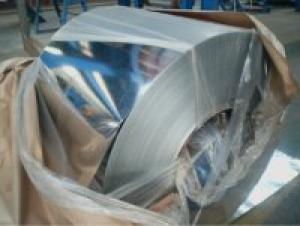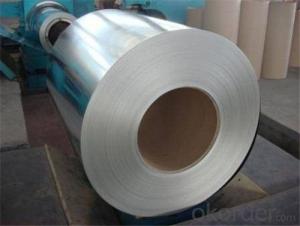High Quality-Hot Dip Galvanized Steel Coil-Regular Spangle
- Loading Port:
- China Main Port
- Payment Terms:
- TT or LC
- Min Order Qty:
- 50mt m.t.
- Supply Capability:
- 5000 tons per month m.t./month
OKorder Service Pledge
OKorder Financial Service
You Might Also Like
General Information Of Hot Dip Galvanized Steel Coil
Hot-dip galvanized steel coils are available with a pure zinc coating through the hot-dip galvanizing process. It offers the economy, strength and formability of steel combined with the corrosion resistance of zinc. The hot-dip process is the process by which steel gets coated in layers of zinc to protect against rust. It is especially useful for countless outdoor and industrial applications.
|
Thickness 0.13-0.7mm (BMT) |
|
Width 600-1250mm |
|
Zinc Coating 30-200g/m2 |
|
Internal Diameter 508mm or 610mm |
|
Coil Weight 3-12MT |
|
Quality Commercial and structural quality |
|
Spangle Regular Spangle |
|
Surface Treatment Oiled/dry , Skin pass/non-skin pass ,Chromated/non-chromated |
|
Standard JIS G 3302, ASTM A 653M, EN 10327 |
|
Steel Grade SGCC, CS, FS, SS, LFQ, DX51D+Z , S280GD |
Chemical Composition Of Hot Dip Galvanized Steel Coil
|
C |
Si |
Mn |
P |
Si |
|
0.04-0.06% |
0.01-0.03% |
0.18-0.22% |
0.014-0.016% |
0.006%-0.009% |
Technical Data Of Hot Dip Galvanized Steel Coil
|
Yield Strength |
(Mpa) 280-320 |
|
Tensile Strength |
(Mpa) 340-390 |
|
Elongation |
20%-30% |
|
Out-of-square |
not exceed 1% Flatness |
|
Bow |
15mmmax |
|
Edge Wave |
9mmmax |
|
Centre Buckle |
8mmmax |
|
Bending At 180 Degree |
No crack, purling and fraction |
Application Of Hot Dip Galvanized Steel Coil
Production of cold formed corrugated sheets and profiles for roofing, cladding, decking, tiles, sandwich walls, rainwater protective systems, air conditioning duct as well as electrical appliances and engineering
With GI as base metal, after pretreatment (degrease and chemical treatment) and liquid dope with several layers of color, then after firing and cooling, finally the plate steel is called pre-painted galvanized steel. Pre-painted galvanized steel is good capable of decoration, molding, corrosion resistance. It generally displays superior workability, durability and weather resistance.

Packaging & Delivery Of Hot Dip Galvanized Steel Coil
Anti-damp paper inside full wrapped with plastic film, iron sheet outside on wooden pallet in 20 feet container with 25mt.

- Q:What is the type of stainless steel used in knifes.
- There okorder / Stainless steel doesn't make the best knife blade. It doesn't sharpen as sharp or hold its edge as well. High carbon steel is better, but it rusts and discolors very easily so it's not as popular. A new thing (actually not new but popular these days) is to use a 'sandwich' of high carbon steel between two layers of stainless. So the actual edge is high carbon steel but the blade looks like stainless. I have some kitchen knives made this way (kind of expensive) and I love them. This same technique was used in Japanese katanas, swords used by samurai warriors.
- Q:What are the different methods of coil slitting for precision cuts?
- Coil slitting, a process utilized for cutting large coils of material into narrower strips, is achieved through various methods that offer distinct advantages and suitability for different applications. 1. Rotary Shear Slitting, the most commonly used method, employs rotating circular knives to shear the material and create multiple strips. The distance between the blades can be adjusted to achieve the desired width. This method guarantees high precision with smooth and burr-free edges. 2. Drag Knife Slitting involves the use of a knife with a drag or tangential orientation that follows the material's contour and produces accurate cuts. It is ideal for materials with irregular shapes and finds application in the textile industry to cut fabrics. 3. Scissor Slitting utilizes two blades that move in a scissor-like motion to cut the coil. This method is commonly employed for thinner materials, providing excellent control and precision. It is ideal for materials prone to deformation or wrinkling. 4. Razor Slitting involves the use of a single or multiple razor blades positioned perpendicular to the material. It is particularly effective for cutting stretchy or delicate materials, minimizing the risk of tearing or deforming. 5. Crush Cutting applies pressure from a hardened steel roller or an anvil against a softer material, causing it to deform and split along the desired cutting line. It is suitable for materials that are challenging to cut with sharp blades, delivering precise and clean cuts. In conclusion, the choice of coil slitting method depends on the material, desired precision, and specific application requirements. Each method offers unique benefits and can be tailored to meet specific cutting needs, ensuring accurate and efficient coil slitting processes.
- Q:I don't know it is low alloy steel or high allow steel or medium carbon steel
- Pretty sure it's low alloy steel, it's harder to smelt as it can contain up to 50% of other elements.
- Q:Is this a strong, durable piece of steel that can take abuse? I'm thinking about using it on a small project.
- I think it might be a bit brittle and could break from metal fatigue.
- Q:What are the different grades of steel used in coil production?
- There are several grades of steel used in coil production, including low carbon steel, high carbon steel, stainless steel, and galvanized steel. Each grade has its own unique properties and is chosen based on the specific requirements of the coil application.
- Q:I have a Charles Daly shotgun and I'm trying to find out if it is ok to shoot steel out of. The side engravings say: Charles Daly 20 GA 3 and the other side says : KBI-HBG, PA made in TurkeyOn their website it says that the barrel on the Charles Daly 300 Field is able to shoot steel but I don't see anywhere that this is a 300 model.Im also not sure if the choke is able to shoot steel. It has no engravings on it. How can I tell if this choke will work? It is the original choke that came with the gun?
- If it has removable choke tubes, just get a MOD or IMP CYL and it will work. If it is a fixed choke, depending upon how old it is, the barrel may be too thing and steel could damage the barrel. If the shotgun is less than 20 years old and with a MOD or more open choke, you should be good to go.
- Q:hi, i have a steel block with an unussual composition. does anyone know if this is any particular type?c- .6%, si - .33%, mn - .6%, sulphur - .014%, phosphorous - .013%, ni - 1.69%, Cr, 1.07%, molybdenum - .67%
- You have opened a can of worms. Specific types of steel vary not only by composition but by the way they were made, their physical properties and their morphology (microscopic structure). The composition you have given would fit for High Carbon Steel and Medium Carbon Steel. Go to the reference I've given, it allows you to put in 3 of the components of your alloy and then it gives you a list of possibilities. You can open each candidate individually and see the full composition. Hours of fun. :)
- Q:What are the different methods of cutting edge trimming for steel coils?
- There are several methods of cutting edge trimming for steel coils, including shearing, slitting, laser cutting, and plasma cutting. Shearing involves using a sharp blade to cut through the coil's edge, while slitting involves using multiple circular blades to make longitudinal cuts. Laser cutting uses a high-powered laser beam to melt and vaporize the material, producing a precise and clean cut. Plasma cutting involves using a high-temperature plasma arc to melt and cut through the steel. Each method has its advantages and is chosen based on factors such as the required precision, speed, and cost-effectiveness.
- Q:I understand that damascus sword steel was made by folding the strip of steele double , reheating, hammering, folding again and so forth hundreds of times. Was this the same or very nearly the same techmique the japs used making the sword blades the samari swords?(forgive the misspelling)
- Actualy, the secrets of forging Damascus steel has been rediscovered. In the 1970s, a Russian scientist found that he could duplicate the steel found in old Damascene swords. While it is true that such swords (which have to be made by hand) would be more expensive than usual, you must keep in mind that the majority of Damascus swords are still forged in Damascus. Syria is a highly inexpensive country, and the price of a Damascus blade, while being expensive to Syrians, would be cheap to Westerners. In reference to your question about wether there is anything special about Damascus steel, the answer is yes. At the time of its creation, Damascus steel was the lightest and most flexiable metal known to man, even lighter than the steel Katana swords used by the Samurai of Japan. During the Crusades, Europeans reported that the Arab blades were capable of bending in the wind, and floating on water. While these are certainly exaggerations, they are proof that Damascus blades were far lighter and stronger than the crude iron weapons used by the Crusaders.
- Q:Hi, I live in the Boston area and I'm trying to find a steel suppler that can provide mild steel for hobby welding. I can go through my job, but we only put in orders every couple of months so it's not very convenient. Also, the few suppliers I've found only sell in bulk. So if anyone knows where I can angle irons, flat bars, sheets, etc... by the piece it would greatly appreciated. Thanks
- They will sell any quantity of metal and even cut it to size - my experience has been that their prices are not wildly out of line for single pieces of full length stock compared to buying singles where you have to buy a minimum. They also may have sizes that ordinary places consider odd. I was looking for 5/8 square 16 gauge and was told it would have to be shipped in from Houston (to Dallas) by my nearest supplier and found it in stock at MetalSM. But check if you get something odd - the 5/8 cost more than 3/4 at both places and MetalSM actually gave me 3/4 but took it back even though I had cut it. Also check the regular steel suppliers in your area as well as retail welders metal supply places.
1. Manufacturer Overview |
|
|---|---|
| Location | Shandong, China |
| Year Established | 2010 |
| Annual Output Value | |
| Main Markets | 33.03% Southeast Asia 33.03% South America 20.18% Africa 13.76% Mid East |
| Company Certifications | ISO9001:2008 |
2. Manufacturer Certificates |
|
|---|---|
| a) Certification Name | |
| Range | |
| Reference | |
| Validity Period | |
3. Manufacturer Capability |
|
|---|---|
| a)Trade Capacity | |
| Nearest Port | Tianjin Port, China |
| Export Percentage | 61% - 70% |
| No.of Employees in Trade Department | Above 100 People |
| Language Spoken: | Chinese, English |
| b)Factory Information | |
| Factory Size: | 10,000-30,000 square meters |
| No. of Production Lines | 10 |
| Contract Manufacturing | OEM Service Offered |
| Product Price Range | Low |
Send your message to us
High Quality-Hot Dip Galvanized Steel Coil-Regular Spangle
- Loading Port:
- China Main Port
- Payment Terms:
- TT or LC
- Min Order Qty:
- 50mt m.t.
- Supply Capability:
- 5000 tons per month m.t./month
OKorder Service Pledge
OKorder Financial Service
Similar products
New products
Hot products
Hot Searches
Related keywords






























